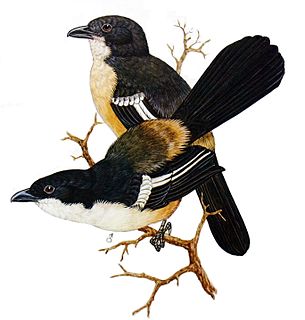Related Research Articles
The link rat is a species of rodent in the family Muridae. It is also known by the common name Congo forest mouse. It is native to central Africa.

The tawny nurse shark is a species of carpet shark in the family Ginglymostomatidae, and the only extant member of the genus Nebrius.
The Rio de Janeiro arboreal rat is a rodent species from South America. It is found in Brazil. It is the only species in the genus Phaenomys.

The rusty pitohui is a species of bird in the family Pachycephalidae. It is found throughout the lowlands of the Aru Islands and New Guinea.

Nepenthes × ferrugineomarginata is a natural hybrid between N. albomarginata and N. reinwardtiana. It has been recorded from the islands of Borneo and Sumatra. The type specimen was collected by Shigeo Kurata in Kenukat, West Kalimantan, in 1981. Kurata described the hybrid the following year. The name is a nomen invalidum as it was published without a Latin description.

The southern boubou is a bushshrike. Though these passerine birds and their relations were once included with true shrikes in the Laniidae, they are not closely related to that family.

The palm weevil Rhynchophorus ferrugineus is one of two species of snout beetle known as the red palm weevil, Asian palm weevil or sago palm weevil. The adult beetles are relatively large, ranging between 2 and 4 centimetres long, and are usually a rusty red colour—but many colour variants exist and have often been classified as different species. Weevil larvae can excavate holes in the trunks of palm trees up to 1 metre (3.3 ft) long, thereby weakening and eventually killing the host plant. As a result, the weevil is considered a major pest in palm plantations, including the coconut palm, date palm and oil palm.

The austral parakeet, austral conure, or emerald parakeet is a parrot found from the southern tip of South America – further south than any other parrot – to as far north as Temuco. It is a fairly large conure, 35 cm. It is primarily green, lightly barred, with some dull red on the forehead and lores, belly, and upper tail, with the northern part of the range displaying less red.

The Cocos cuckoo is a species of cuckoo in the family Cuculidae. It is endemic to Cocos Island, an island in the Pacific Ocean which is part of Costa Rica.

Ozothamnus ferrugineus, the tree everlasting, is a shrub or small tree, native to the states of New South Wales, Victoria and Tasmania in Australia. It grows to between 2 and 5 metres in height.

The Kopuatai Peat Dome is a large peatland complex on the Hauraki Plains in the North Island of New Zealand. It consists of two raised domes, one in the north and the other in the south, that are up to three metres higher at the center than at the edge. The 10,201 hectares wetland contains the largest intact raised bog in New Zealand and was listed under the Ramsar Convention in 1989 as a Wetland of International Importance. Most of the wetland is ombrotrophic, meaning it receives water and nutrient inputs solely from rain and is hydrologically isolated from the surrounding canals and rivers. Locally, a popular misconception persists that water flows from the nearby Piako River into the bog and that the wetland acts as a significant store for floodwater.

Tylopilus ferrugineus is a bolete fungus in the family Boletaceae native to North America. Originally described by Charles Christopher Frost in 1874 as Boletus ferrugineus, it was placed in the genus Tylopilus by Rolf Singer in 1947.

Onciderini is a tribe of longhorn beetles of the subfamily Lamiinae, they are prevalent across Europe in nations such as Turkey, and Finland.
Eudesmus is a genus of longhorn beetles of the subfamily Lamiinae, containing the following species:
Eudesmus caudalis is a species of beetle in the family Cerambycidae. It was described by Henry Walter Bates in 1865.
Eudesmus diopites is a species of beetle in the family Cerambycidae. It was described by Dillon and Dillon in 1946. It is known from Peru.
Eudesmus grisescens is a species of beetle in the family Cerambycidae. It was described by Audinet-Serville in 1835. It is known from Brazil, Bolivia, Nicaragua, Peru and French Guiana.
Eudesmus nicaraguensis is a species of beetle in the family Cerambycidae. It was described by Stephan von Breuning in 1958. It is known from Nicaragua.
Eudesmus posticalis is a species of beetle in the family Cerambycidae. It was described by Félix Édouard Guérin-Méneville in 1844. It is known from Brazil.
Eudesmus rubefactus is a species of beetle in the family Cerambycidae. It was described by Henry Walter Bates in 1865. It is known from French Guiana and Brazil.
References
- ↑ BioLib.cz - Eudesmus ferrugineus. Retrieved on 8 September 2014.